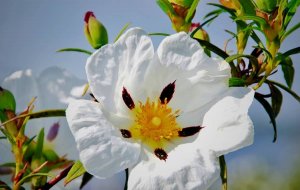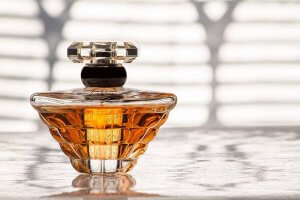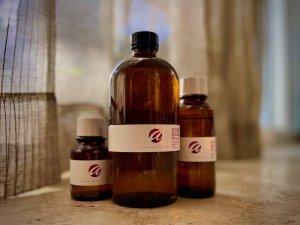What are Chypre fragrances, how do they fit within the world of perfumery and how have they evolved over time? Our perfumers explore one of the most beautiful, complex fragrance families within the fragrance wheel.
The exact origins of the word, ‘chypre,’ the spelling of which at first may seem like a typo, are long faded into the mists of time. It is known, however, that the word itself dates back to the Middle Ages and translates into French as Cyprus.
This Greek island, which is renowned for its gloves scented with oak moss, was at one time at the helm of the perfume trade because of its strategic location as a crossroads between the East and the West.
The Cypriots produced perfumes in a tradition that continued for centuries. They were deftly blended with resins and ambrosial spices from Egypt and Asia and local, sweet smelling plants and ingredients such as: deep, potent and rich labdanum.

They formulated Eau de Chypre, which was a masculine, scented water that was crisp, rugged and energizing, and exported it all across the continent. French perfumers later adapted the recipe to their own tastes.
Chypre made its modern debut in the world of fragrance in 1917 with the launch of Chypre de Coty, which was the creation of iconic perfumer, Francois Coty.
This marked the establishment of chypre as a fragrance family, and defined its modern structure as a perfume built upon an accord comprised of five specific facets. This include citrus in the form of spicy, light and refreshing bergamot, floral, which can be either dreamy, musky rose or haunting, intense jasmine, woody, and can include: rich, deep and potent labdanum, slightly sweet patchouli, green, earthy oak moss and rich dark ambery facets.

This family of perfumes is perhaps the most beautiful and complex of all those found on the iconic Fragrance Wheel.
No matter how many different facets are merged and blended within this perfume family, the results are always woody to some degree. Known for their robust character and aura of elusive mystery, these fragrances are powerful mosaics that play upon a contrast between cool and warm aspects.
They are evocative of forests primeval, woody undergrowth and green, musty mosses. They can be either masculine or feminine, depending on added facets. They are highly favored among our master perfumers at Alpha Aromatics.

How Have Chypre Fragrances Evolved Over Time?
Since it was first developed, perfumers have reinterpreted and tweaked the chypre accord many times.
Over the years, the family has evolved tremendously, and while classical chypres are often dark and rich, newer formulations are more transparent, and are sometimes comprised of heavier notes of rich, leathery labdanum and strong, earthy oak moss blended with a softer touch of patchouli.
The classical chypre structure is always initiated with an energizing burst of citrus aspects (most frequently bergamot), which are soon followed by a floral heart note of romantic, musky rose, haunting and intoxicating jasmine or rich, sugary and narcotic, ylang ylang.
Deep, woody notes of green, moist moss, potent and musky patchouli and complex, leathery labdanum usually constitute the final dry down of these intriguing fragrances.

The quintessential character of chypre fragrances concerns a one-of-a-kind, almost magical olfactory tapestry of sensations marked by dazzling head notes that sharply diverge from the warmer, darker and muskier base notes. These scents are unlike all others in character as they evoke more abstract, ethereal sensations.
Classical varieties are marked by their dark and rich elements while modern versions are formulated from a new family of sheer ambers known for a transparency that is balanced with depth and sophistication.
There can also be enormous variation in the proportions of the ingredients used in chypre fragrances.
In some instances, an expected facet may not be present and others maybe added in its stead, creating a new aspect for the scent. For example, green notes render a green chypre, and additional citrus elements will develop into a fragrance similar to eau de cologne.
A Few Of Our Recently Designed Chypre Fragrances
The following represent a few of our master perfumers’ most recently composed Chypre fragrances, which are ideal for application within a diverse array of scented products, including candles, diffuser oils, fine perfume and more.
Amberwood Freesia
This fragrance streams with head notes brimming with warm, inviting and ambrosial cassis, spicy, complex bergamot and uplifting grapefruit.
A middle note soon takes hold marked by facets of honey, minty and strawberry-nuanced freesia, romantic, musky rose and haunting, intense jasmine.
A woody dry down of elegant, lush vanilla, warm, rich and honeyed amberwood, dark, masculine patchouli and clean, dry austere cedar completes this glorious fragrance.
Cashmere Sambac
Opening head notes stream with facets of clean, fresh lemon, tangy, woody-nuanced red raspberry and fuzzy, fruity apricot.
A middle note soon takes hold featuring light, bitter neroli, leathery, amber-nuanced and musky black rose, haunting jasmine and sweet, green and rich sambac.
The scent completes with a base note characterized by exotic cashmere woods, slightly powdery and velvety sandalwood, lush vanilla and dark, sensual patchouli.
Mimosa Blossom Musk
The top notes of this fragrance oil burst with citrus facets of fresh lemon, floral, refreshing bergamot and succulent orange.
These aspects soon drift into a heart note bouquet featuring a melange of floral, bitter, neroli, ambrosial, powdery and green mimosa, mellow, soft and sweet lavender, intense jasmine, creamy gardenia and musky, romantic rose.
A potent dry down of sensual patchouli, pungent, velvety civet, dark, erotic musk, strong, earthy and wet forest-nuanced oak moss and elegant, lush vanilla complete this intriguing fragrance.
Rosewood Nectarine
Brimming with top notes of sugary, fresh and spicy bergamot and apricot-peachy nectarine, these elements soon fold into a heart note of rich, floral, and jasmine-tinged Ylang Ylang, powdery, woody orris root, sugary, floral rosewood and waxy, creamy tuberose.
A final dry down of woody, buttery sandalwood, dark, sensual patchouli, passionate musk and dry, earthy and green oak moss complete this unforgettable fragrance.
Sandalwood Osthmantus
This intoxicating fragrance streams with opening facets of sweet, dark and berry-nuanced cassis, fruity plum, clean, fresh lemon and succulent mandarin.
These aspects soon flow flawlessly into a heart note featuring ambrosial, fleshy, rich and incredibly fruity osthmantus, floral, bitter neroli, musky, dreamy rose, aquatic, green and spicy hyacinth, fiery, clove-like carnation and fresh, slightly pungent coriander.
The fragrance completes with a base note marked by earthy, patchouli, potent green oak moss, creamy sandalwood, radiant, velvety civet and dark, honeyed amber.
The Enduring Tradition of Alpha Aromatics
We are a pioneer and leader within the perfume industry, consistently providing fine fragrances for private label brands, personal care products, candles and diffusers, house cleaning products, industrial air fresheners and so much more.
Our roots stretch back to the early 1940s and have been a part of the Pittsburgh landscape equally as long, and we specialize in natural, organic and synthetic fragrances, accommodating the dynamic and diverse demands of all industries concerned with utilizing ambient branding to improve traffic, sales and their bottom line.
Contact our teams today, and let us help you shine among your competitors with your own uniquely-blended Chypre fragrance.

Photo Credits: Pixabay and Alpha Aromatics
 alpha aromatics®
alpha aromatics®